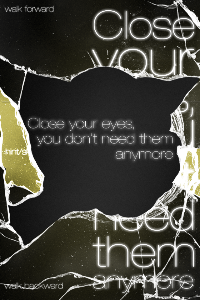


"A meticulously designed, audio-driven thriller... just as engrossing for players who can see as for those who cannot." - Laura Parker, The New Yorker
"Blindside does something rare: making accessibility for blind players a generative space for invention. A design constraint that blossoms into something altogether new." - Sara Hendren, Gizmodo / Abler
"Making a mark on both sighted and blind players" - Richard Moss, Polygon
"Audio-only horror masterpiece" - Joseph Bernstein, Kill Screen
BlindSide on MSNBC
BlindSide is an audio-only adventure game. Aside from a splash screen, menus, HUD, and credits, the game is otherwise completely graphics-less. Instead of using their eyes, players explore their environment guided only by what they can hear around them in the virtual world. Based on a personal experience of my co-developer, Aaron Rasmussen, who was temporarily blinded in a high school chemistry accident, BlindSide simulates the experience of being blind, generating 3D audio through standard stereo headphones. This allows BlindSide's players to navigate the game's virtual world, and offers an identical gameplay experience for both sighted and visually impaired gamers. On iOS devices, this effect is further enhanced by an innovative gyro control scheme, which allows players to change which way their avatar is facing in-game just by rotating their body in the real world.
iOS in-game HUD
Aaron and I each worked on both the design and programming of BlindSide. We conceived of the game over a brunch, the premise stemming from a fusion of Aaron's ideas for a script (based on his personal experiences with blindness), and my game design background and familiarity with Robin Arnott's audio-only game, Deep Sea. Aaron's story seemed like a great fit for a game, and I saw the opportunity to build upon earlier audio games, which typically involved players in large open environments, moving towards or away from certain sounds. 24 hours later, I had a working prototype of Case's apartment up and running in Unity, giving proof of the game's core concept. We Kickstarted the game (pre-Double Fine Adventure), raising more than $14,000 with the support of 585 backers, allowing us to purchase Unity licenses, hire a sound designer, and pay for our monster SFX.
Example level layout
Unity allowed me to construct a fully physical 3D grey block world for players to stumble through. This feature sets BlindSide apart from other audio games. Players must find their way through realistic bounded spaces (such as an apartment or classrooms) modeled on real-world locations which are crowded with furniture and other site-specific obstacles. Players can bump their shins into coffee tables, stumble into locked doors, and hear the squeak as they slide along mirrors. In addition to providing a more engaging and realistic sightless experience, BlindSide's fully physical world allowed for the inclusion of techniques which visually impaired individuals use in real life. For example, in BlindSide we model a common practice known as "trailing." In the real world, individuals extend an arm, and walk while sliding their hand along the surface of a wall to allow them to place where they are as they move through a room. In BlindSide, if a player in contact with an object presses the up arrow and moves forward along the edge of that object, they hear a sliding sound. This sound changes based on the material of the object, and fluctuates in pitch based on the angle and speed at which they are moving along it. Our simulation of this real-world tactic has been lauded by our players, both for its authenticity and its efficacy in aiding player navigation.
BlindSide presented a set of unique design challenges as a result of its audio-only format, however, iteration in overcoming those obstacles allowed us to develop features that have come to define the game, including its 1-to-1 gyro controls, trailing, and Case's "remembered" narration system. With these and other graphics-less design solutions, BlindSide delivers an intensely immersive experience that thrills sighted and visually impaired players alike. I am proud that BlindSide has been able to simultaneously push at the edges of what can be built with iOS devices, while helping to expand a promising and under-explored design space for both mobile and desktop platforms.
BlindSide won the Most Innovative Award in the 10th Annual Games for Change Festival in 2013, was nominated a finalist in IndieCade 2012, and was nominated for two awards from the 2012 Brazilian International Game Festival. The game is available for download on the App Store (iOS) and Desura (PC/Mac). For best iOS experience, play on an iPhone 4S, iPad 2, or iPad 3. BlindSide is also compatible with iPhone 4, iPad, iPad mini, and iPod 4.
Aaron Rasmussen & Michael T. Astolfi
Credits:
Game Design, Development, & Sound Design - Michael T. Astolfi
Game Design, Development, & Sound Design - Aaron Rasmussen
Additional Sound Design - Jose Frias
Voice Acting:
Michael T. Astolfi as Case
Michelle Ciotta as Dawn
Paul Resnikoff as Alan
Andrea Kornstein as Cindy
Tom Astolfi as the Emergency Broadcasting System
Clifton Highfield as the Monster









